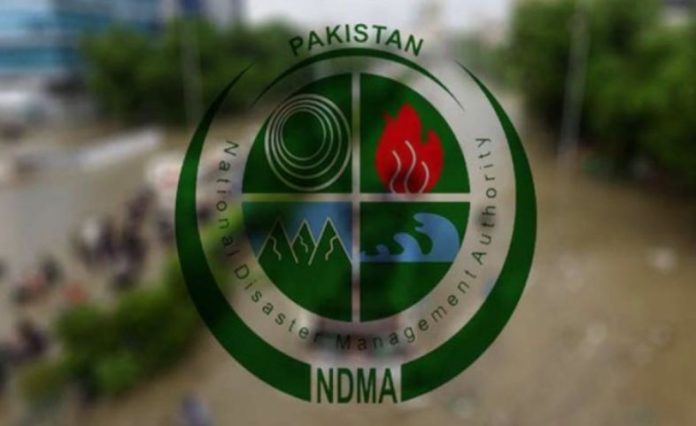ISLAMABAD, AUG 17 (DNA): Chairman National Disaster Management Authority (NDMA) Lieutenant General Inam Haider on Sunday warned that two to three additional monsoon spells are likely in the coming weeks, with rainfall intensity projected to surge 50 to 60 percent above previous years.
Addressing a media briefing on rain-related damages and flood response, the NDMA chief said this year’s monsoon spread has expanded significantly due to unusually high summer temperatures, which triggered atmospheric instability and heavier rainfall across multiple regions.
He attributed the heightened severity to climate change, which continues to intensify weather disruptions in vulnerable regions. Pakistan is witnessing severe repercussions, with widespread destruction reported in Buner, Bajaur and Battagram areas increasingly exposed to climate-driven hazards.
“The monsoon season is expected to persist until September 10,” he said.
Lieutenant General Haider said land connectivity has been severed with several settlements in Gilgit-Baltistan and Khyber Pakhtunkhwa due to flash floods and landslides. Search operations for missing persons are ongoing, while relief goods and food supplies are being dispatched to affected districts.
Restoration work is underway in areas where link roads have been damaged. NDMA remains in constant coordination with provincial governments to ensure timely assistance and effective response. More relief packages will be delivered on Monday to districts that have suffered the highest loss of life during recent monsoon-related disasters.
The NDMA chairman emphasized that all available resources will be mobilized to minimize potential flood-related losses. Vulnerable areas will be evacuated in advance to safeguard lives, while communication networks in cut-off regions will be restored on a priority basis through technical teams.
Following the monsoon season, NDMA will work closely with the Ministry of Communications and the Ministry of Housing to rehabilitate damaged infrastructure.
Lt Gen Inam Haider attributed the recent devastation in northern districts to climate change, warning that northern Punjab and northern Khyber Pakhtunkhwa are likely to experience more intense rainfall in the coming days. He assured that the NDMA, in coordination with relevant ministries, will sustain rehabilitation efforts and issue regular updates to help minimize future losses.
The restoration drive will prioritize reconnecting isolated regions and is expected to be completed before the onset of the next monsoon cycle.
Armed forces are assisting in ongoing relief and rescue operations. A detailed survey, in coordination with provincial governments, will be conducted to assess exact losses. Relief camps will be established if necessary to provide shelter and support to displaced communities.
Earlier, officials from the NDMA briefed the media on a comprehensive monsoon contingency plan, identifying regions most vulnerable to heavy rainfall and potential flooding. According to the briefing, northeastern areas—including Azad Jammu and Kashmir and central Khyber Pakhtunkhwa—along with southeastern districts such as Tharparkar, Sujawal, Tando Allah Yar, Tando Muhammad Khan, and Badin are likely to experience intensified monsoon activity.
The NDMA highlighted that three major weather systems are currently converging over Pakistan, which is expected to significantly amplify rainfall across the country
NDMA Technical Expert Dr. Tayyab Shah stated that the ongoing rainfall sequence is expected to continue until August 22, with further intensification likely. He added that another monsoon spell will begin after August 22, with three additional rainfall systems approaching the region.
He noted that a new rainfall sequence is approaching from the Bay of Bengal, while another system is advancing from Afghanistan’s Nangarhar and Kandahar regions.
NDMA General Manager Zahra Hassan stated that heavy rainfall is expected within the next 24 to 48 hours, warning that Tarbela Dam is currently at 98 percent capacity and may reach a critical level during this period. She further noted that water levels have risen by up to 15 feet at Katarian and Gwalmandi bridges along Nullah Leh.
A new rainfall sequence has commenced in areas along the Koh-e-Suleiman mountain range. Flood risks have escalated in Azad Jammu and Kashmir’s Neelum, Poonch, and Bagh districts. In Khyber Pakhtunkhwa, vulnerable areas include Peshawar, Chitral, Dir, and Charsadda, where flood threats remain particularly high.
Brigadier Kamran, Member Operations at NDMA, stated that preparations for the monsoon season began as early as February 2025, with preventive measures undertaken in coordination with provincial governments to minimize potential damage. However, he noted that the recent devastation in Buner and Bajaur was triggered by sudden cloudbursts.
According to Brigadier Kamran, 337 lives have been lost and 178 individuals injured over the past two days. He stated that the army and Frontier Corps are actively supporting provincial governments with resources for ongoing rescue operations. A second consignment of relief goods from the federal government is scheduled to be dispatched to Buner on Monday.

















